Part 2: Dances of Western Europe and its Colonies
4 Dances of Colonial North America
1. Introduction
As places whose populations are largely colonial immigrant-based, North and South America have a vast number of dance traditions. We, of course, have dances of the indigenous Native American, Canadian First Nations, Alaska Natives, as well as the indigenous populations of Mexico, Central America, and South America. We also have dances that are descended from Spanish traditions, which we discuss in chapter 6. There are dances in the US that come from every region of the world that followed immigrants from those nations. It is an amazing tapestry of ethnicities and cultures. There’s no way I can do justice to each of these traditions. We also can’t remotely touch on all the forms of what might be considered folk dance that have emerged on their own in the new world such as Hip Hop, Latin Dance, Tap, etc. There’s just too much to cover. This chapter is limited to just one tiny subset of folk dancing from North America: the dance styles that were inspired by the dance traditions of British and French colonial rulers of North America.
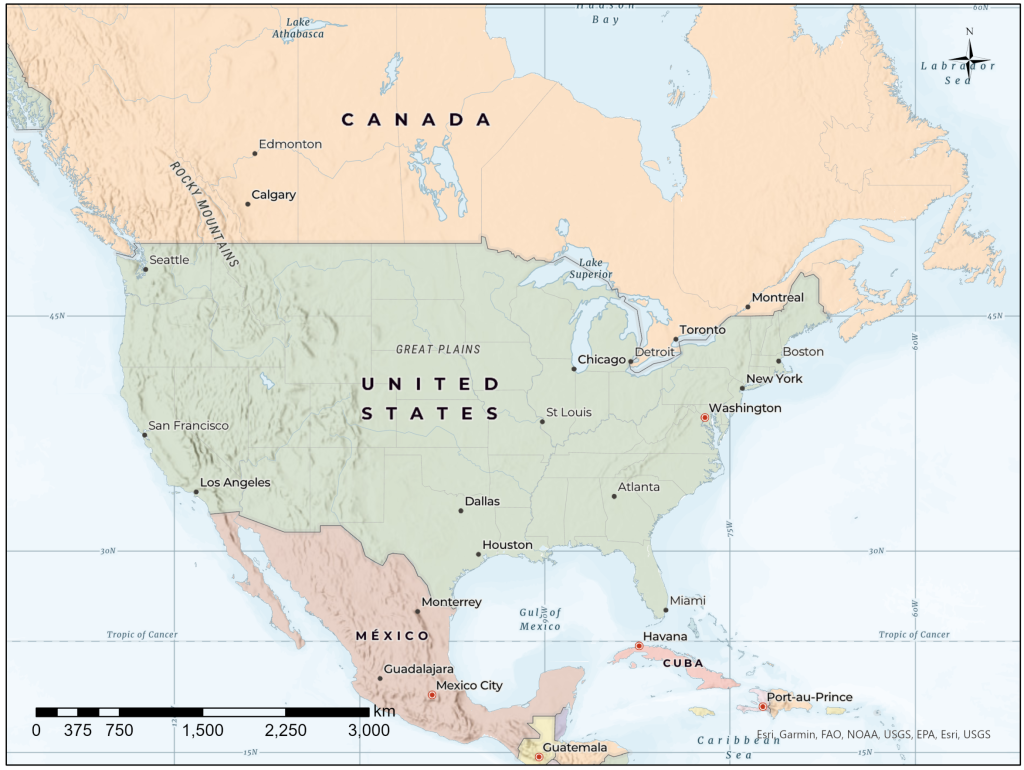
Let’s note up front that this is a very skewed and narrow view of what constitutes American and Canadian traditional dance. It is definitely a traditional colonialist view and doesn’t acknowledge the important contributions of either the indigenous or other immigrant populations of the continent.
2. Set and Step Dances of Québec
Québec (pronounced kay-bek, not kwee-bek) is one of 10 Canadian provinces. It is bordered on the west by Ontario and Hudson’s bay, in the North by the Arctic ocean, in the east by the Maritime provinces of Newfoundland and New Brunswick and in the south by the US states of Maine, New Hampshire, Vermont and New York. Its major cities, Montréal and Québec City, along with the major cities in Ontario form a corridor along the St. Lawrence River and into the Great Lakes. About 50% of Canada’s population live in this part of Canada.
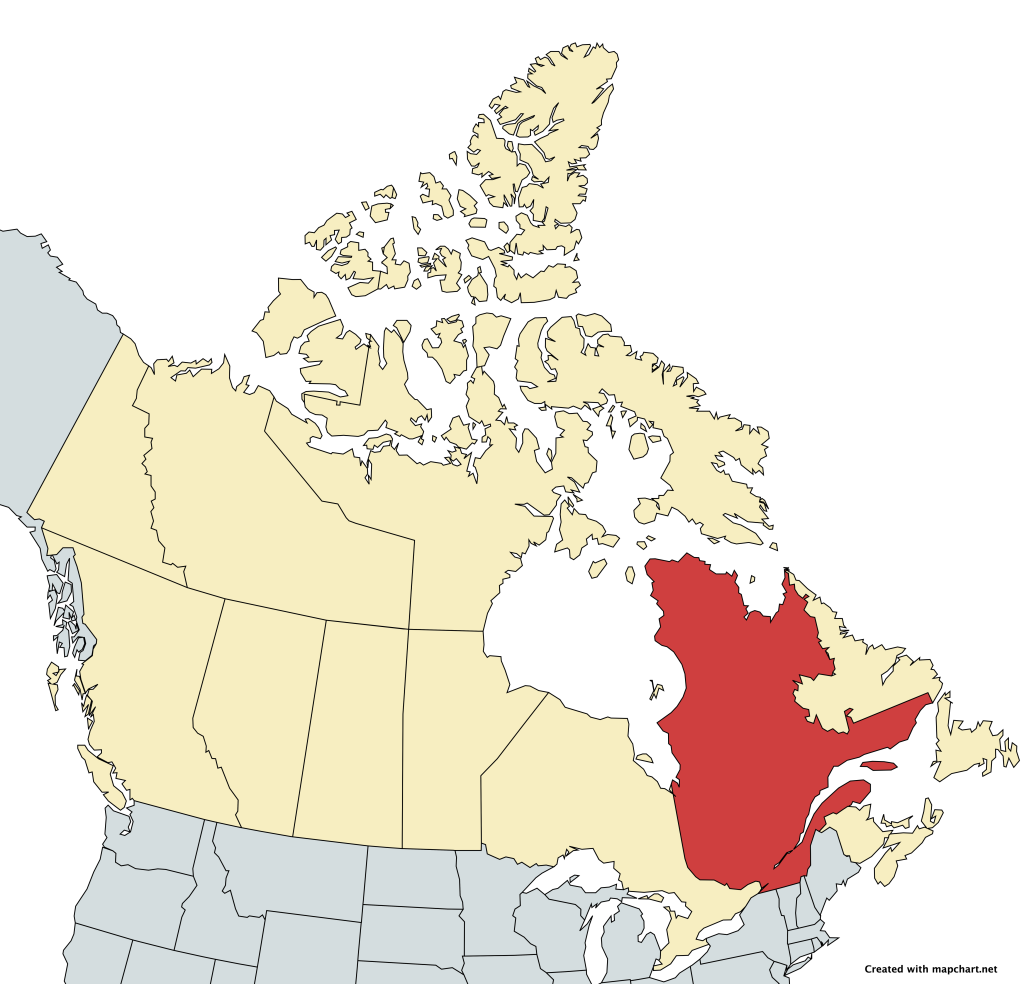
Québec is a unique part of North America. It is the only political entity on the continent that has a French-speaking majority population. French is the only official language in the province; English is a minority language. Within Canada, Québec has a unique constitutional status, and The Québecois have initiated several separatist independence movements.
The original inhabitants of the province were the Algonquians, Iroquoians, and Inuits. The territory was conquered by the French as New France and heavily settled by French speakers. But the region also saw a very large influx of Irish and Scottish settlers who had a profound effect on the music and dance of the region. In 1759, the British Army defeated the French at the battle of the Plains of Abraham, and the French surrendered the territory. It has been part of the dominion of Canada ever since, but it has retained the French language and French legal system. Québec was originally known as Lower Canada during British Reign.
Québecois music is heavily influenced by that of Scotland and Ireland. Most of the music are traditional reels and jigs. The most obvious difference in the music is in the instrumentation. The primary instruments in French Canadian music are the piano and the fiddle, sometimes a guitar. Percussion is often done by someone making complex taps on a board with their feet or by banging two spoons together.
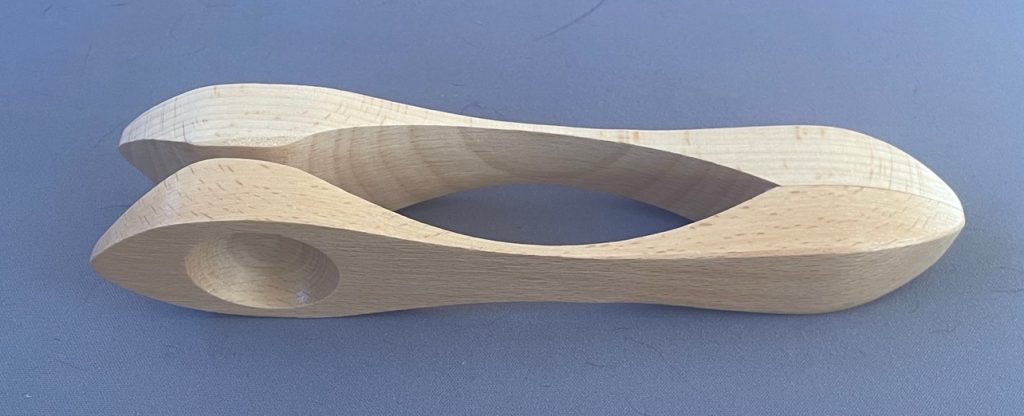
The costumes for French Canadian dancing reflect the clothing worn by the voyageurs (fur traders) of the 18th and 19th century. The women wear patterned knee length skirts, white aprons, and lace hats. The men wear knee length britches, vests and a characteristic colorful woven belt called a ceinture fléchée which is characterized by a distinctive arrow-like weave. Both men and women wear hard soled shoes to make noise as they clog through the dances.
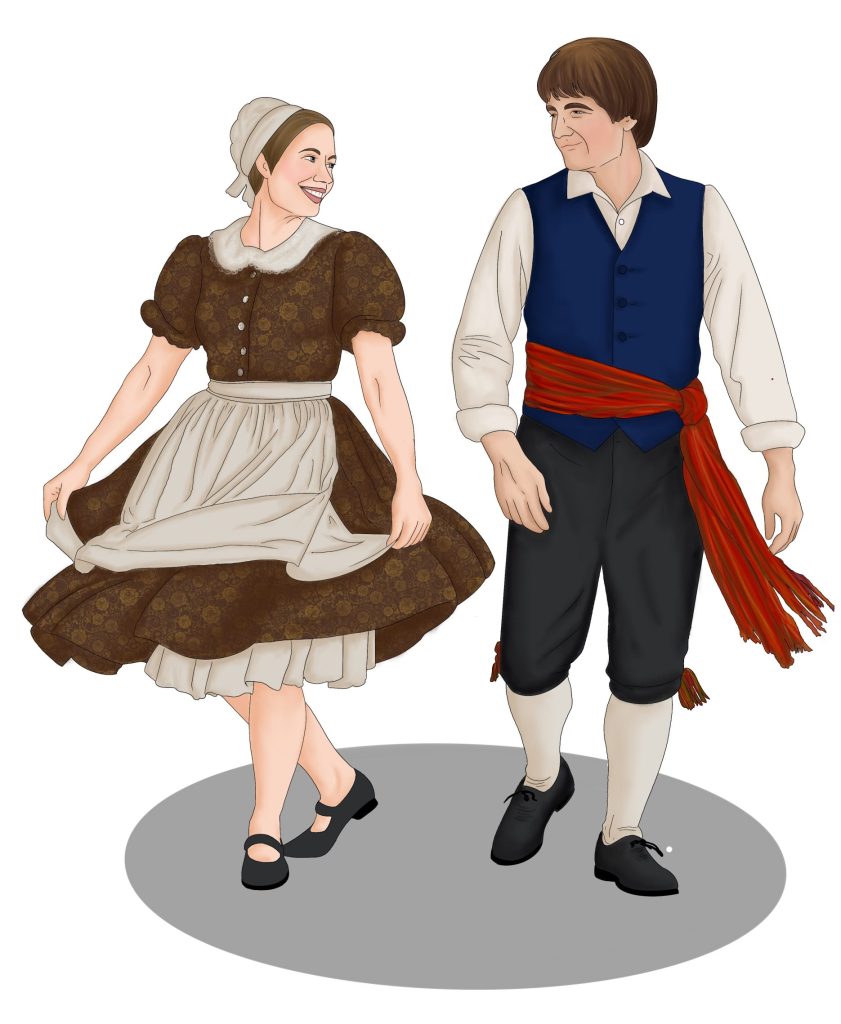
The majority of French Canadian dances are couple dances performed in squares. They maintain the traditions of the Quadrille (or set) borrowed from the Irish and French, where there is a complex set of memorized figures. The French Canadian dances differ from the Irish and Scottish dances in that they are typically accompanied throughout by “La gigue” (the jig), which is the tapping foot movements found in clog dances. La gigue is done while the dancers form the figures.
- Quebecois Fiddle: https://youtu.be/hqN5sfqL9Rs?si=x4-nS3MgF9cY99Rk
- An album of Quebecois folk music: https://youtu.be/BUKfmuK5gdE?si=79AO0unSneEQkBrF
- Québecois set dancing: https://youtu.be/tQsF6An2vPI?si=qIcdH3vR0A58hXIc
- Québecois step dancing: https://youtu.be/AtzaBreU9ts
- Québecois step dancing: https://youtu.be/xcgv9kVy29g?si=VSmeEk3n5kP2vwy-
3. Red River Jigging
A closely related tradition to the Québecois dances is the dancing of the Métis people of Manitoba and Saskatchewan. The Métis are the community of First Nations Peoples of Manitoba who are descended from a mix of the indigenous populations in these provinces and French settlers. Their dances also involve la gigue and set formations. The style of jigging or clogging done by the Métis is however much more energetic and spectacular than that of the Québecois. They also do the dances in a different style of costume, where both the men and the women wear shirts with long colorful fringes sewn onto the chest, along the back and onto the sleeves. The women’s skirts also have these fringes along the bottom.
This dance form is particularly interesting to folk dance scholars because it represents one of a very few cases of an indigenized dance style. What we mean by this, is that a local native community has adopted a cultural tradition of their colonizers, but made it something that is uniquely theirs alone and distinct from the original dances.
- Métis Jigging from Manitoba: https://youtu.be/UGU7aOhz-Uc
- Métis Jigging from Manitoba 2: https://youtu.be/hrwdjm_7M6w?si=_IHfs0sDBfJczkpQ
4. Contra Dances of New England
Among the original colonies of the US, we have the region that is now known as New England (Maine, New Hampshire, Vermont, Massachusetts, Connecticut, Rhode Island). These states were the birthplace of a style of dance known as Contra Dancing. However, the tradition of Contra Dancing, however was (and is) found along the entire east coast, including the south. New Englanders also took the dances to the places they migrated to, such as the Midwest. It is nonetheless known as New England Contra Dancing, no matter where it is done.

There are two hypotheses about the origin of the name “Contra Dance”. One hypothesis is that it is a corruption of the term “Country dance” (cf. English Country Dance, Scottish Country dance). The other is that it refers to the fact that you dance facing your partner in a longwise set (i.e., contra or against your partner).
Modern Contra dancers have their own particular uniform. Women typically wear sleeveless one piece knee length straight dresses in floral or solids. Men typically wear jeans and T shirts. And since the 60s, those T-shirts are often tie-dyed. One recent trend is that men have started wearing floor length skirts to dance in. This wearing of skirts seems to have nothing to do with sexuality or gender identity. It appears to be the case that the dancers just like the feel of the skirt when dancing. This has become the norm at many contra dances.
Many early contra dances are identical to English Country dances (ECD) that bear the same names. The style of the dancing is quite different than ECD though. It’s typically very fast with tight turns. The dancers swing longer and more aggressively than in ECD. In between the figures the dancers often do extra flourishes and spins. The dances are usually done in “duple minor” sets within a longwise set (e.g. 4 people dance together in the longwise set, progressing to dance with a new couple each time.) Most modern contras are done improper, meaning that the active couple in each minor set does the dance crossed over from the traditional side. Contra dance is very much a living tradition and new dances are being choreographed all the time. Contra dances are always called. This means that there is a person at the head of the hall who calls out the figures done by the dancers (Parkes 1992, Page 1984, Holenko 2009).
One subgroup of contra dance is Gender-Role Free Dancing. This style of dance, founded by Chris Ricciotti in the early 1990s, was originally done by the LGBTQ+ community (where it is sometimes called Queer Contra), but it has since gained much wider acceptance. In Gender-Role free dancing, the traditional roles of the “man” and the “woman” are abandoned. People of either gender can dance either role. If the dance figures distinguish two distinct roles they are renamed, depending upon the dance community, as “bands” and “bare-arms” (for communities where the leader position wears an armband), “Larks” and “Robin”, or “leaders” and “followers”.
- Modern Contra dance video #1 (note the men in skirts): https://youtu.be/Xyhl89yGMFA
- Modern contra dance video #2 (more traditional music): https://youtu.be/jcYOIXIMfJQ
- Modern contra dance video #3 (Jazzy music, but the dancers are doing a really old traditional figure from the 1600s called “Petronella”): https://youtu.be/STRUiouGqQ4
5. Traditional Square dancing and Modern Western Square Dancing.
Square dances are the most common kind of British-derived dances found throughout the US west. They are, as their name would suggest, done by groups of 4 couples arranged in a square. Like Contra dances, Square dances in the US are called, where the dancers do the figures called out by the leader. Traditional squares had fixed figures that the dancers could learn, however.
In the 1940 and 1950s, a new tradition of square dancing emerged called “Modern Western Square Dancing” (MWSD). MSWD is different from traditional square dancing in that you really need to go to classes to learn the figures that correspond to the calls. The calls are organized by difficulty (Basic, Mainstream, Plus, Advanced, Challenge) and you have to attend classes at each level in order to attend dance events that use those levels of calls. During a MSWD, each set of dances consists of two parts. First you have a hash or patter call, which is then followed by a singing call to a popular country western or pop song. The patter calls are like a game. The caller leads the dancers through a complicated and improvised set of patterns, which never repeat. The caller tries to then get the dancers back to their original positions thus “resolving the dance”. Singing calls, by contrast, have a predictable chorus figure that fits the words to the song, in between the choruses the dancers still have to follow the improvisations of the caller, but these are usually less complex.
MWSDers have a very distinctive costume. The men wear jeans, western style cowboy shirts, with kerchiefs or bolo ties around their necks. The women wear skirts, that come just above the knee. They typically wear very large crinoline petticoats underneath these skirts, which gives them a very distinctive look, where at the most extreme can make the skirts come up to waist level. Often the couple is color coordinated.
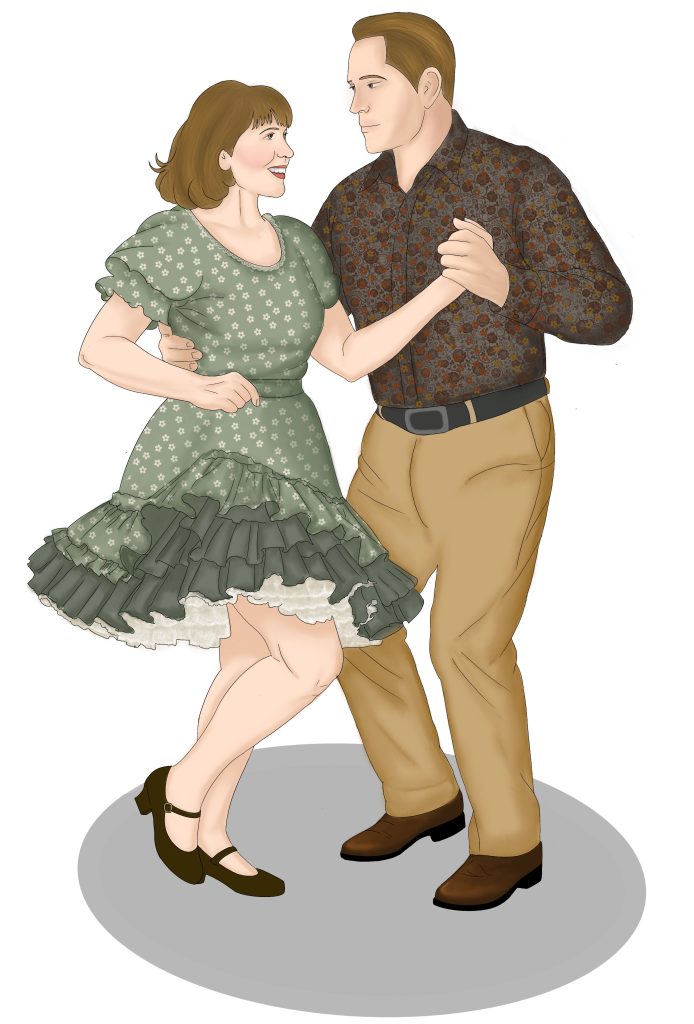
- Ken Bower Patter call: https://youtu.be/4EXbaNMISCo
- Rick Gittleman doing a singing call: https://youtu.be/fF7InC4i5d8
- MWSD “patter call” followed by a “Singing call”: https://youtu.be/xH0L8Jcir1A
6. Country Western Two-Step and Round Dancing
In addition to the set dances discussed above, Americans also adopted the European traditions of couple dances like the Waltz, Polka, One-step and Two-step. In the south and west these dances came to be set to country western music in a style known as Country Western Two Step, Country Two-Step, Mountain Two-Step or Texas Two-Step. This style of dance progresses counterclockwise around the room as the dancers execute asymmetric three bar footwork while doing various fancy moves such as having the follower turn under the leader’s arm. Country Western Two Step is improvised by the couple as they work their way around the room.
Round Dancing is similar to the two-step, except instead of being improvised the dancers do specific choreographies, which like Square and Contra dancers are called by a caller[1]
- Round Dancing: https://youtu.be/PtCkO5Og-H4
- Two Stepping: https://youtu.be/bDPq_gry78I
7. Cajun Dancing and Zydeco
The Acadians are the French speaking settlers of the Maritime provinces of Nova Scotia, New Brunswick and Prince Edward Island. After the French-Indian war of the 1750s, the British rulers of Canada decided to expel the Acadians from Canadian territories. Around 16000 Acadians were forcibly removed from Eastern Canada. Many of them travelled to the French Territory in the southern United States that eventually became Louisiana. These people became who we know as the Cajuns. Cajun music has a distinct sound to it and is played on the diatonic button accordion, the fiddle, the mouth organ or harmonica, the guitar, and bass guitar. One characteristic instrument is the washboard, used for percussion. Many of the tunes are the same as those found in Québec or New England, but they have a syncopation in them where the primary emphasis falls on the 2nd and 4th beat of a 4/4 bar rather than on the 1st and 3rd beat, as is common in other styles. The music was influenced by the music of African Slaves and Native people.

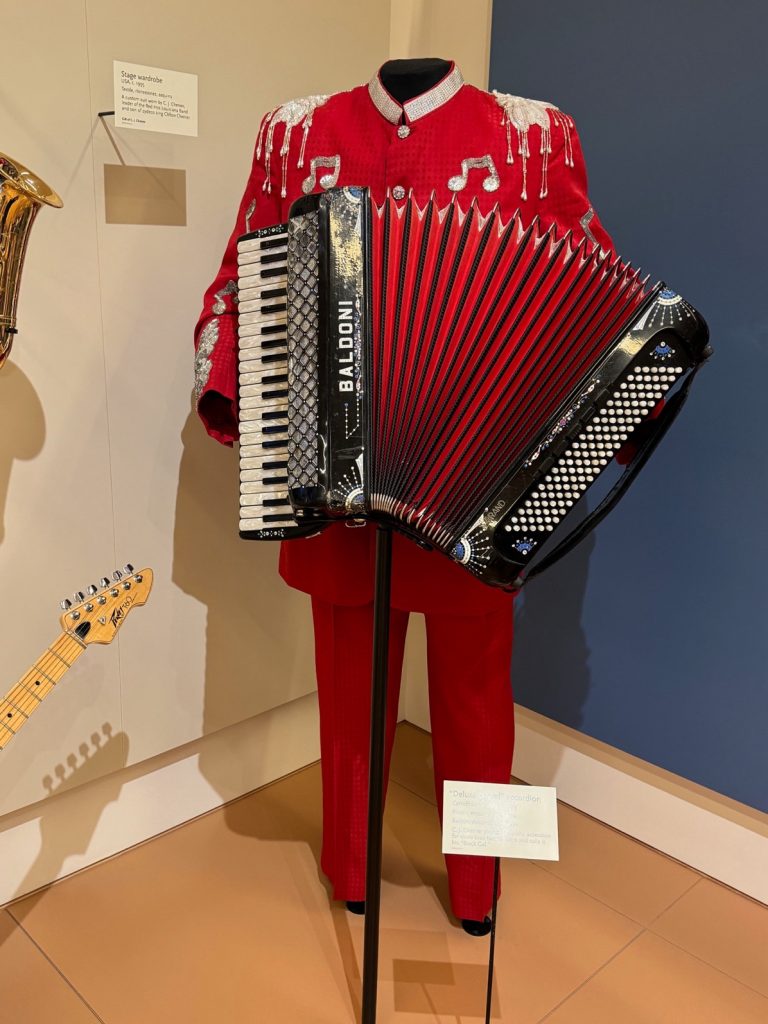
A unique style of dance developed at Cajun dance parties called fais-do-dos. This term is thought to refer to what a mother would say to her child to get them to sleep, so she could go and dance. Cajun two-steps and jitterbugs have a unique up down motion to them. The Cajun Two-Step moves around the room like the Country Western Two-Step. The jitterbug stays mainly in place, holding two hands open, with the couple rotating clockwise around each other very fast. While the dancers are moving they execute complex arm movements like you find in swing dancing and German dancing turning around each other and connecting into knots. There is also a more sedate Cajun waltz, but again the dancers will often show off with complex turns.
Zydeco is a closely related music and dance tradition. It comes from the African American communities who lived adjacent to the Cajun settlers. One difference between the two styles is that Zydeco music had more influence from Gospel Music and Blues music than Cajun music does. In more recent times Zydeco music has also seen more influence from classic Rock and Roll. You’re more likely to hear electric instruments in a Zydeco Band. There are also differences in the instruments used. While Cajun music uses a single row button accordion, Zydeco musicians tend to use a multirow button accordion or a piano accordion. Zydeco music also typically uses a washboard played with spoons as its primary percussion.
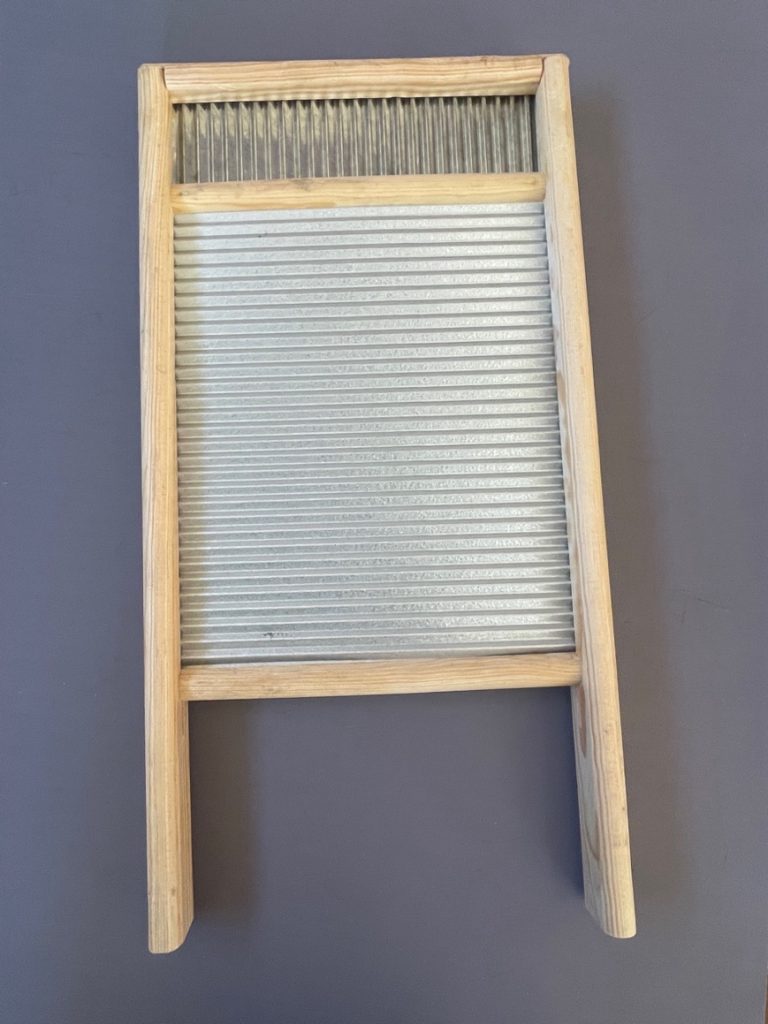
Zydeco dancing is very similar to Cajun dancing but has some important stylistic differences. The dancers almost always stay in a closed ballroom position. The dance moves side-to-side rather than around the room. They also dance closer to their partners than Cajun dancers do. The dancer’s hips move more and the dances are more sexually suggestive. Today, if you go to a Louisiana dance party in most places, you’re likely to actually dance to a mix of Cajun and Zydeco music with a mix of the two dance styles.
- Cajun two-step/jitterbug music: https://youtu.be/lWBC966NVD8?si=kPWOPFwEIHAnW2ce
- Cajun Waltz music: https://youtu.be/E21zCPZ3kds?si=Qzrjh4C0ntDwaFoC
- Zydeco Music: https://www.youtube.com/live/s8-bnEPs2aA?si=L2pwLhxGDWpwfHB2
- Cajun Waltz: https://youtu.be/JtiiJe_g1RU?si=4_BmHzHM2sENc45N
- Cajun Jitterbug: https://youtu.be/BpLt1asGgEw?si=9L0nj-NHkjVRqSJV
- Cajun Two Step: https://youtu.be/XqCech_BphE?si=29RghoMfl4tno6xk
- Zydeco Dance: https://youtu.be/b-hIcNBmOcM?si=wXEiMvD4BBDw5e8h
- Documentary on Zydeco: https://youtu.be/mgv8tQ-15MA?si=Thp1yPA6Q2xciZCN
8. Clogging and Tap Dancing
British and Irish settlers also brought their clogging traditions with them when they immigrated to the USA. The heartland of this tradition lies in the Appalachian Mountains. Appalachian clogging is characterized by large movements and knee lifts and a loose upper body (Hinds 1984)
It is thought that tap dancing is directly related to clogging. African American slaves and their descendants merged traditional African dance styles with clogging and set it to jazz. Another form of dance that comes to us via traditional clogging is modern western white shoe clogging. This form of dance is called by a caller like a square dance. The dancers who do white shoe often wear sneakers with “jingle taps” on them. Jingle taps are a double layer of metal, that make noise just by shaking the foot. The taps used in tap dancing and traditional clogging are usually a single layer of metal.
- Traditional Appalachian Clogging: https://youtu.be/cs2j8f7H2WY
- Modern Appalachian Clogging: https://youtu.be/Pctzc3v5Cx0
- Tap Dancing: https://youtu.be/LBQOfyR75vY
- Called White Shoe Clogging; https://youtu.be/kj2yhAi3wDE
9. Line Dancing
American line dances are a relatively recent innovation. The first clear line dance was a novelty dance called “the Madison”, which was done in the Midwest in the late 1950s. Line dances are done by dancers scattered around the room all facing the same direction. Later developments created what are called 4-wall dances, where the dancers make a ¼ turn each time through the dance to face a new wall in the room. Line dances are done to a wide variety of music, from country and western, like the Boot Scoot and Boogie, to disco music like the Electric Slide, to Latin music and rock and roll. The dance style has spread around the world and is very popular in Asia in addition to the USA.
- Boot Scoot ‘n Boogie: https://youtu.be/RsOTbdARQSc
- Cumbia Semana: https://youtu.be/A4-8McI-e_4
- Electric Slide: https://youtu.be/VoCZsFGVsy4?si=AjFXjntbOtyV2rVx
- Saturday Night Fever: https://youtu.be/LnqWQnbvjuQ?si=LSPe1tr15CPkU_iT
- The Madison: https://youtu.be/w6QWoLXJ9Z4?si=IHk1qlZru7re6Aks
- The Bus stop: https://youtu.be/zF-O8yfrBD0?si=AqiDgEYl11XN5lpa
- The Cupid Shuffle: https://youtu.be/h24_zoqu4_Q?si=9XeNx34XgvhfA1Oo
- Rock around the clock: https://youtu.be/7LOs6YPq5II?si=ZX3gzOYf0QOUn627
Further Reading
- Anonymous (2004), Burchenal (1918), Callerlab (n.d), Casey (1976), Fix (1991), Gunzenhauser (1996), Greene (1984), Hall (1963), Hinds (1984), Holenko (2009), Jennings (1983), Kraus (1950), Owens (1949), Page (1984), Parkes (1992), Phillips (1968), Ricciotti (2005), Smith (1955). See the reference section at the end of this book for full citations.
- https://en.wikipedia.org/wiki/Line_dance
- http://socialdance.stanford.edu/Syllabi/Madison.pdf
Some Suggested Dances for Teaching
- La Bastringue: http://folkdancemusings.blogspot.com/2014/03/la-bastringue-quebec-canada.html
- Les Saluts: http://folkdancemusings.blogspot.com/2014/07/les-saluts-quebec-canada.html
- Fiona’s Saunter: http://folkdancemusings.blogspot.com/2011/09/fionas-saunter-usa.html
- Cotton Eyed Joe: http://folkdancemusings.blogspot.com/2014/01/cotton-eyed-joe-line-dance-version-usa.html
- Frederick Contra: http://folkdancemusings.blogspot.com/2015/05/frederick-contra-usa.html
- Inflation Reel: http://folkdancemusings.blogspot.com/2015/05/the-inflation-reel-usa.html
- Trail of the Lonesome Pine: http://folkdancemusings.blogspot.com/2014/08/trail-of-lonesome-pine-usa.html
- Cercle Haute Taille: https://folkdancemusings.blogspot.com/2023/09/cercle-haute-taille-usamartinique.html
- Boot Scoot ‘n Boogie: http://folkdancemusings.blogspot.com/2014/06/boot-scoot-and-boogie-usa.html
- Electric Slide: http://folkdancemusings.blogspot.com/2014/06/electric-slide-usa.html
- Teton Mountain Stomp: http://folkdancemusings.blogspot.com/2014/01/teton-mountain-stomp-usa.html
- Swiss Break Mixer: https://folkdancemusings.blogspot.com/2023/07/swiss-break-mixer-break-mixer-de-vogeli.html
- Cajun Cross line dance: https://folkdancemusings.blogspot.com/2021/09/cajun-cross-usa.html
- Cajun Jitterbug: http://folkdancemusings.blogspot.com/2015/09/cajun-jitterbug-or-cajun-jig-usa.html
Discussion Questions
Discussion Question 1
In this chapter, we didn’t discuss a number of dance styles that have emerged in the US and Canada that might legitimately be called folk dances: Disco, Swing Dancing, Break Dancing, Hip Hop, Krump, Crunk and many others. Using the criteria discussed in chapter 1, discuss whether these forms are folk dances or not.
Discussion Question 2
In the section on Red River jigging, we discussed how this style of dance was an indigenized form of dances borrowed from the colonizers but now unique to the Métis. Is this a case of cultural appropriation? Why or why not?
Media Attributions
- Figure 4.1: Map of North America © John W. W. Powell (2024) Used with Permission. Additional geospatial data cited in map.
- Figure 4.2: The Province of Québéc. © Created with http://www.mapchart.net adapted by Andrew Carnie is licensed under a CC BY-SA (Attribution ShareAlike) license
- Figure 4.3: French Canadian Spoons © Andrew Carnie, personal collection
- Figure 4.4: French Canadian Dance Costumes © Asma, used here with permission
- Figure 4.5: New England © Created with http://www.mapchart.net adapted by Andrew Carnie is licensed under a CC BY-SA (Attribution ShareAlike) license
- Figure 4.6: Square Dance costumes © Asma, used here with permission
- Figure 4.7: Mouth Organ or Harmonica © Andrew Carnie, personal collection.
- Figure 4.8: Clifton Chenier’s Cajun Accordion © Musical Instrument Museum, used with permission
- Figure 4.9: Washboard used for percussion © Andrew Carnie, personal collection.
- In round dancing, they don’t call the caller a “caller”, instead they are named a “cuer” and the calling is called “cueing”. ↵

